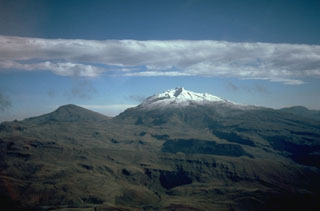Report on Chiles-Cerro Negro (Colombia-Ecuador) — 20 July-26 July 2022
Smithsonian Institution / US Geological Survey
Weekly Volcanic Activity Report, 20 July-26 July 2022
Managing Editor: Sally Sennert.
Please cite this report as:
Global Volcanism Program, 2022. Report on Chiles-Cerro Negro (Colombia-Ecuador) (Sennert, S, ed.). Weekly Volcanic Activity Report, 20 July-26 July 2022. Smithsonian Institution and US Geological Survey.
Chiles-Cerro Negro
Colombia-Ecuador
0.817°N, 77.938°W; summit elev. 4698 m
All times are local (unless otherwise noted)
Instituto Geofísico de la Escuela Politécnica Nacional (IGEPN) and the Observatorio Vulcanológico y Sismológico de Pasto del Servicio Geológico Colombiano (SGC OVSP) both monitor the Cerro Negro de Mayasquer and Chiles volcanoes, called the Chiles-Cerro Negro volcanic complex (CCNVC), and both issued reports on the seismic swarm that began on 27 May. This seismicity was mainly characterized by VT earthquakes, typically indicating rock fracturing events. The swarm continued during 12-26 July, though the number and size of events were variable. The earthquakes were located along a fracture zone on and as far as 3.5 km S of Chiles volcano, at depths less than 6 km. The number of long-period (LP) and very-long-period (VLP) earthquakes, low-energy events indicating fluid movement, had increased in the previous two weeks; 60 of such events were recorded on 17 July, the highest daily number of events recorded since the beginning of permanent monitoring in November 2013, and 64 were recorded in 20 July. During 12-23 July a total of 43 earthquakes had local magnitudes greater than 2; four of those events, a M 3.3 recorded at 1038 on 16 July, a M 2.8 at 0816 on 22 July, a M 3.5 at 1746 on 22 July, and a M 3 at 2247 on 23 July were all felt in surrounding areas, including in the municipality of Cumbbal, in the department of Nariño. At 0833 on 25 July a M 5.6 was recorded, with a hypocenter located about 10 km S of Tufiño (Carchi province, Ecuador). Building damage was reported in San Gabriel, Tulcán, and El Ángel (Ecuador) and in the Municipalities of Túquerres and Cumbal (Colombia).
Data from continuous GPS geodetic bases located in the vicinity of the Chiles volcano showed a trend of inflation at a rate of approximately 28 mm/year that has been recorded since 2016 (the beginning of deformation monitoring) through the end of 2020, when the deformation stabilized. Neither inflation nor deflation was detected during the beginning of 2020 or in 2021. Inflation was again detected in March, at a rate of 32 mm/year. The rate of inflation notably increased during April-July to an average of 106 mm/year, occurring in at least two deformation zones, one S of Chiles and another in the Potrerillos caldera. The Alert Level remained at 3 (Yellow; the second lowest level on a four-color scale).
Geological Summary. The Chiles-Cerro Negro volcanic complex includes both the Pleistocene Chiles and the Cerro Negro de Mayasquer stratovolcanoes astride the Colombia-Ecuador border. Cerro Negro has a caldera open to the west, with andesitic and dacitic lava flows of possible Holocene age (Hall 1992, pers. comm.) and solfataras on the shore of a small crater lake. An eruption reported in 1936 may have been from Reventador (Catalog of Active Volcanoes of the World). The higher, glacier-covered summit of Chiles, about 4 km ESE of Cerro Negro, last erupted about 160,000 years ago, but it has a caldera open to the north with hot springs and an active hydrothermal system on its eastern flank.
Sources: Instituto Geofísico-Escuela Politécnica Nacional (IG-EPN), Servicio Geológico Colombiano (SGC)

